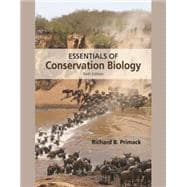Essentials of Conservation Biology, Sixth Edition, combines theory and applied and basic research to explain the connections between conservation biology and ecology, climate change biology, the protection of endangered species, protected area management, environmental economics, and sustainable development. A major theme throughout the book is the active role that scientists, local people, the general public, conservation organizations, and governments can play in protecting biodiversity, even while providing for human needs.
Each chapter begins with general ideas and principles, which are illustrated with choice examples from the current literature. The most instructive examples are discussed in boxes highlighting projects, species, and issues of particular significance. Chapters end with summaries, an annotated list of suggested readings, and discussion questions. This new edition comes with extensive summary statements in the text margins, as study aids.
Essentials of Conservation Biology, Sixth Edition, is beautifully illustrated in full color, and is written in clear, non-technical language, making it well-suited for undergraduate courses.
RESOURCES
For Instructors
Instructor's Resource CD-ROM This resource includes all figures (line-art illustrations and photographs) and tables from the textbook, provided as both high- and low-resolution JPEGs. All have been formatted and optimized for excellent projection quality. Also included are ready-to-use PowerPoint presentations of all figures and tables.








